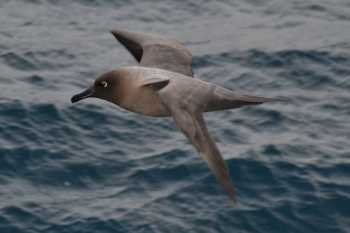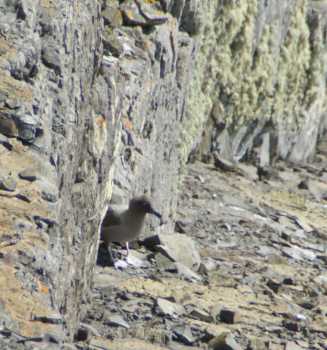The Light-mantled Albatross Phoebetria palpebrata has a circumpolar distribution in the Southern Ocean and exhibits the most southerly distribution of all the albatross species. It generally stays near or below the Antarctic Polar Front, dispersing as far south as 77-78ºS in the Ross Sea and south of 60ºS elsewhere around the Antarctic Continent, regularly venturing to the edge of the pack ice.
On 17 December 2011 up to five Light-mantled Albatrosses were seen repeatedly over two hours and photographed by Juan Pablo Seco Pon flying close by and on the surface from the m.v. Corinthian II while steaming from the east coast of the Trinity Peninsula, Antarctica in the Bransfield Strait between the South Shetland Islands and the Antarctic Peninsula at 63º 03'S, 57º 59'W. The Trinity Peninsula is the extreme northern portion of the Antarctic Peninsula. These records seem to be at or close to the edge of the species' known southerly range within the region.

Light-mantled Albatross in the Bransfield Strait, December 2011
Photograph by Juan Pablo Seco Pon
In the austral summer of 2008/2009 a breeding colony of Light-mantled Albatrosses (c. five pairs) was discovered on a small offshore rock ("Flat Top") connected to the Fildes Peninsula, King George Island, South Shetland Islands at 62° 12'S, 59° 01'W (click here). This is the southernmost breeding locality of any albatross species recorded, and the only one within the area of the Antarctic Treaty System (ATS; south of 60°S) and thus falling outside a national authority. The only other ACAP-listed species known to breed within the ATS region is the South Giant Petrel Macronectes giganteus (click here).

"Flat Top": Site of the Light-mantled Albatross breeding colony on the Fildes Peninsula, King George Island
Photograph by Simeon Lisovski

Light-mantled Albatrosses breeding on "Flat Top", Fildes Peninsula, King George Island
Photographs by Simeon Lisovski
The five albatrosses seen from the Corinthian II would have been well within the foraging range of this colony, although they could just as well have come off from breeding colonies farther north on South Georgia (Islas Georgias del Sur)*.
The Light-mantled Albatross usually appears to forage alone or in small groups of less than five birds, as supported by the observations presented here. It was surprising to observe the birds flying close to the vessel (sometimes within two metres), as the species is not known to be particularly attracted to ships when compared to most other albatross species.
Click here to access the ACAP Species Assessment for the Light-mantled Albatross which summarizes its known at-sea distribution.
Selected References:
Ainley, D.G., O'Connor, E.F. & Boekelheide 1984. The marine ecology of birds in the Ross Sea, Antarctica. Ornithological Monographs No. 32. 97 pp.
BirdLife International 2004. Tracking Ocean Wanderers: the Global Distribution of Albatrosses and Petrels. Results from the Global Procellariiform Tracking Workshop, 1-5 September, 2003, Gordon's Bay, South Africa. Cambridge: BirdLife International. 100 pp.
Lawton, K., Kirkwood, R., Robertson, G. & Raymond, B. 2008. Preferred foraging areas of Heard Island albatrosses during chick raising and implication for the management of incidental mortality in fisheries. Aquatic Conservation Marine and Freshwater Ecosystems 18: 309-320.
Lisovski, S., Pavel, W., Weidinger, K. & Peter, H.-U. 2009. First breeding record of the light-mantled sooty albatross (Phoebetria palpebrata) for the maritime Antarctic. Polar Biology 32: 1811-1813.
Phillips, R.A., Silk, J.R.D. & Croxall, J.P. 2005. Foraging and provisioning strategies of the light-mantled sooty albatross at South Georgia: competition and co-existence with sympatric pelagic predators. Marine Ecology Progress Series 285: 259-270.*
Weimerskirch, H. 1998. Foraging strategies of southern albatrosses and their relationship with fisheries. In: Robertson, G. & Gales, R. ( Eds). Albatross Biology and Conservation. Chipping Norton: Surrey Beatty & Sons. pp. 168-179.
Weimerskirch, H. & Robertson, G. 1994. Satellite tracking of Light-mantled Sooty Albatrosses. Polar Biology 14: 123-126.
Weimerskirch, H., Jouventin, P. & Stahl, J.-C. 1986. Comparative ecology of the six albatross species breeding on the Crozet Islands. Ibis 128: 195-213.
With thanks to Simeon Lisovski and Hans-Ulrich Peter for information and photographs.
Juan Pablo Seco Pon, ACAP South American News Correspondent & John Cooper ACAP Information Officer, 1 January 2012
*A dispute exists between the Governments of Argentina and the United Kingdom of Great Britain and Northern Ireland concerning sovereignty over the Falkland Islands (Islas Malvinas), South Georgia and the South Sandwich Islands (Islas Georgias del Sur y Islas Sandwich del Sur) and the surrounding maritime areas.

 Français
Français  English
English  Español
Español